BM312 Entrepreneurship: Case Study Analysis of a Business Venture
VerifiedAdded on 2023/06/07
|10
|2101
|386
Case Study
AI Summary
This case study analyzes the entrepreneurial journey of Amanda Bennett, who identified a market gap for fashionable, wide-calf boots. Her initial success with outsourced manufacturing in China led to rapid sales. However, a second shipment of low-quality boots, due to cheaper materials and poor production, resulted in significant losses and business closure in 2014. The analysis explores Amanda's characteristics as an entrepreneur, identifies the key innovation challenges, and discusses managerial lessons learned. The case also considers alternative strategies to prevent supply problems, such as due diligence and venture capital, to mitigate risks. The conclusion emphasizes the importance of quality control and strategic planning in entrepreneurship, highlighting the impact of innovative ideas on business success and failure.
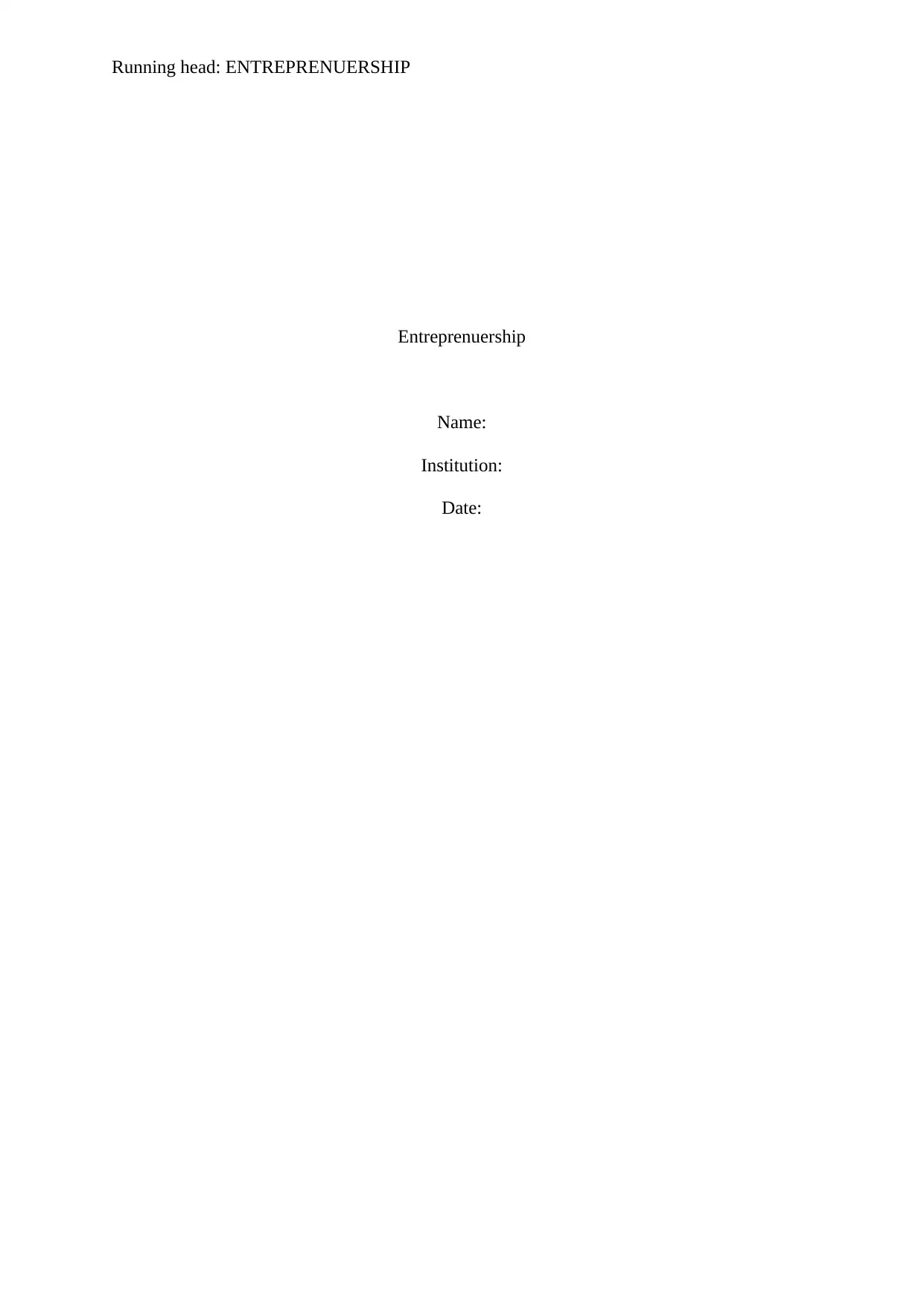
Running head: ENTREPRENUERSHIP
Entreprenuership
Name:
Institution:
Date:
Entreprenuership
Name:
Institution:
Date:
Paraphrase This Document
Need a fresh take? Get an instant paraphrase of this document with our AI Paraphraser

ENTREPRENUERSHIP
Executive Summary
Amanda Bennett is an entrepreneur who identified a market gap in which woman
struggled to get fashionable fitting boots due to their wider calves. Amanda had identified a
potential market that could really lead to a boom in her business. An innovative idea made
her outsource manufactured boots in China, where she had stayed and worked for quite some
times. Amanda had a breakthrough in her first shipment where her boots were outsold in a
matter of weeks and there were others who lined up after the stock depleted. This was a major
breakthrough and a chance to expand her business after the first successful stint in trade.
Amanda and her husband mortgaged their house to finance the second batch of their boots
but this was a disappointment. It came as a low quality Chinese production with cheap leather
and cheap zips. The reception was poor from their customers and 80% of the boots never sold
due to their quality. With many costs like rent and a weak cash flow, Amanda had to wind up
her business in 2014. She blamed the business fall or closure on cultural differences between
the Chinese and Australia where she come from Melbourne.
Executive Summary
Amanda Bennett is an entrepreneur who identified a market gap in which woman
struggled to get fashionable fitting boots due to their wider calves. Amanda had identified a
potential market that could really lead to a boom in her business. An innovative idea made
her outsource manufactured boots in China, where she had stayed and worked for quite some
times. Amanda had a breakthrough in her first shipment where her boots were outsold in a
matter of weeks and there were others who lined up after the stock depleted. This was a major
breakthrough and a chance to expand her business after the first successful stint in trade.
Amanda and her husband mortgaged their house to finance the second batch of their boots
but this was a disappointment. It came as a low quality Chinese production with cheap leather
and cheap zips. The reception was poor from their customers and 80% of the boots never sold
due to their quality. With many costs like rent and a weak cash flow, Amanda had to wind up
her business in 2014. She blamed the business fall or closure on cultural differences between
the Chinese and Australia where she come from Melbourne.
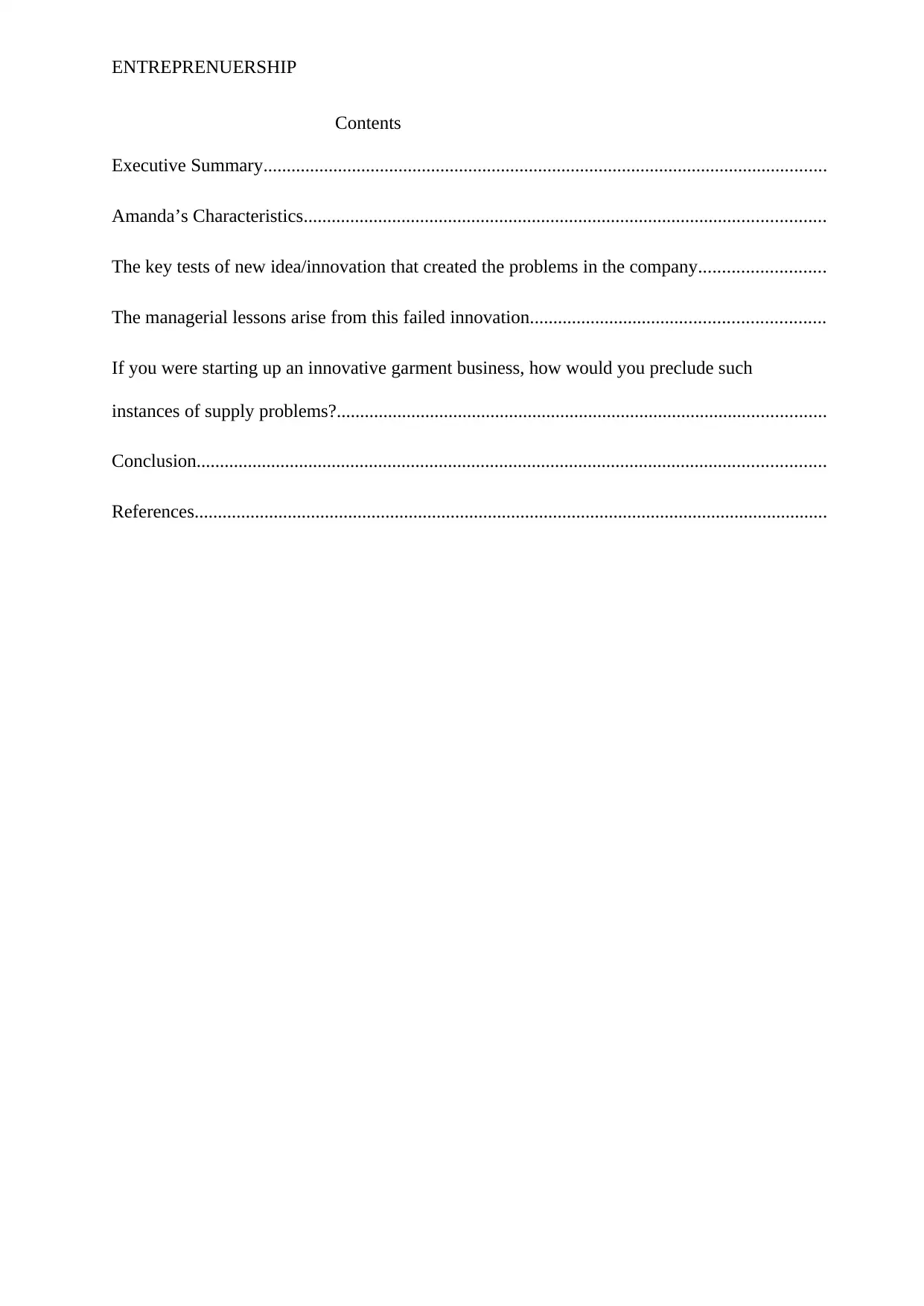
ENTREPRENUERSHIP
Contents
Executive Summary.........................................................................................................................
Amanda’s Characteristics................................................................................................................
The key tests of new idea/innovation that created the problems in the company...........................
The managerial lessons arise from this failed innovation...............................................................
If you were starting up an innovative garment business, how would you preclude such
instances of supply problems?.........................................................................................................
Conclusion.......................................................................................................................................
References........................................................................................................................................
Contents
Executive Summary.........................................................................................................................
Amanda’s Characteristics................................................................................................................
The key tests of new idea/innovation that created the problems in the company...........................
The managerial lessons arise from this failed innovation...............................................................
If you were starting up an innovative garment business, how would you preclude such
instances of supply problems?.........................................................................................................
Conclusion.......................................................................................................................................
References........................................................................................................................................
⊘ This is a preview!⊘
Do you want full access?
Subscribe today to unlock all pages.

Trusted by 1+ million students worldwide
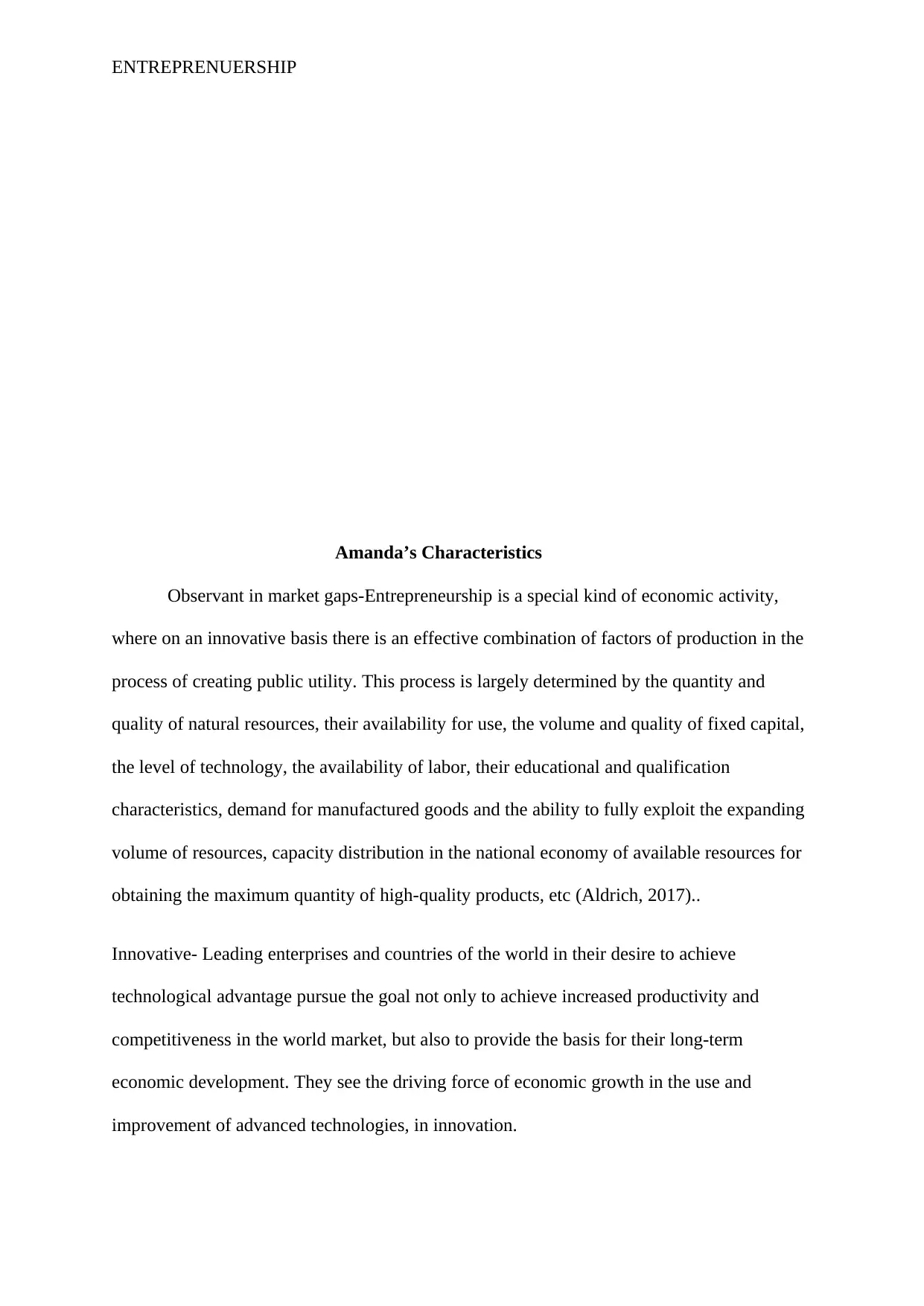
ENTREPRENUERSHIP
Amanda’s Characteristics
Observant in market gaps-Entrepreneurship is a special kind of economic activity,
where on an innovative basis there is an effective combination of factors of production in the
process of creating public utility. This process is largely determined by the quantity and
quality of natural resources, their availability for use, the volume and quality of fixed capital,
the level of technology, the availability of labor, their educational and qualification
characteristics, demand for manufactured goods and the ability to fully exploit the expanding
volume of resources, capacity distribution in the national economy of available resources for
obtaining the maximum quantity of high-quality products, etc (Aldrich, 2017)..
Innovative- Leading enterprises and countries of the world in their desire to achieve
technological advantage pursue the goal not only to achieve increased productivity and
competitiveness in the world market, but also to provide the basis for their long-term
economic development. They see the driving force of economic growth in the use and
improvement of advanced technologies, in innovation.
Amanda’s Characteristics
Observant in market gaps-Entrepreneurship is a special kind of economic activity,
where on an innovative basis there is an effective combination of factors of production in the
process of creating public utility. This process is largely determined by the quantity and
quality of natural resources, their availability for use, the volume and quality of fixed capital,
the level of technology, the availability of labor, their educational and qualification
characteristics, demand for manufactured goods and the ability to fully exploit the expanding
volume of resources, capacity distribution in the national economy of available resources for
obtaining the maximum quantity of high-quality products, etc (Aldrich, 2017)..
Innovative- Leading enterprises and countries of the world in their desire to achieve
technological advantage pursue the goal not only to achieve increased productivity and
competitiveness in the world market, but also to provide the basis for their long-term
economic development. They see the driving force of economic growth in the use and
improvement of advanced technologies, in innovation.
Paraphrase This Document
Need a fresh take? Get an instant paraphrase of this document with our AI Paraphraser

ENTREPRENUERSHIP
Strategist- The thesis that industry and government should closely cooperate in this, united by
a common innovation policy into a strategic union of a new type, serves as a guide for all
participants in this process. It is implied that industry is more interested in short-term
investments, in research and development, since the government, in general, is expected to
support basic research. This alliance is all the more significant that the advanced positions
achieved by the enterprise or country do not provide guarantees for the preservation of their
primacy (Alvarez, & Barney,2017).
The key tests of new idea/innovation that created the problems in the company
In the context of globalization, more and more facts testify to the importance of
accelerated innovation, without which it is already difficult to maintain leadership, and it is
also impossible to maintain a dynamic balance of society: traditional or static methods cannot
be maintained by the usual methods, and the dynamic balance requires non-stop
development. If we are talking about underdeveloped countries, then they have a chance to
catch up with the leaders left behind and ensure their technological primacy if they are able to
master a strategically correct model of innovative self-development. Keywords: innovative
entrepreneurship, nonlinearity, self-development, strategy.
The actions that could have been taken, if anything, to prevent these problems
For Amanda, due diligence could have been done on the quality of the second batch of boots
that she was bringing home from china. Quality is everything to her customer. Compromising
on quality only sought to end the innovative business idea. She could also be cautious on the
expansion strategy that she was using (Godfrey & Schulze, 2017).
Through innovative activity of the business entity, through the implementation of innovations
in technology and technologies, the methods of creating and using them, technical progress is
being made. The scientific and technological revolution gives entrepreneurship an innovative
Strategist- The thesis that industry and government should closely cooperate in this, united by
a common innovation policy into a strategic union of a new type, serves as a guide for all
participants in this process. It is implied that industry is more interested in short-term
investments, in research and development, since the government, in general, is expected to
support basic research. This alliance is all the more significant that the advanced positions
achieved by the enterprise or country do not provide guarantees for the preservation of their
primacy (Alvarez, & Barney,2017).
The key tests of new idea/innovation that created the problems in the company
In the context of globalization, more and more facts testify to the importance of
accelerated innovation, without which it is already difficult to maintain leadership, and it is
also impossible to maintain a dynamic balance of society: traditional or static methods cannot
be maintained by the usual methods, and the dynamic balance requires non-stop
development. If we are talking about underdeveloped countries, then they have a chance to
catch up with the leaders left behind and ensure their technological primacy if they are able to
master a strategically correct model of innovative self-development. Keywords: innovative
entrepreneurship, nonlinearity, self-development, strategy.
The actions that could have been taken, if anything, to prevent these problems
For Amanda, due diligence could have been done on the quality of the second batch of boots
that she was bringing home from china. Quality is everything to her customer. Compromising
on quality only sought to end the innovative business idea. She could also be cautious on the
expansion strategy that she was using (Godfrey & Schulze, 2017).
Through innovative activity of the business entity, through the implementation of innovations
in technology and technologies, the methods of creating and using them, technical progress is
being made. The scientific and technological revolution gives entrepreneurship an innovative
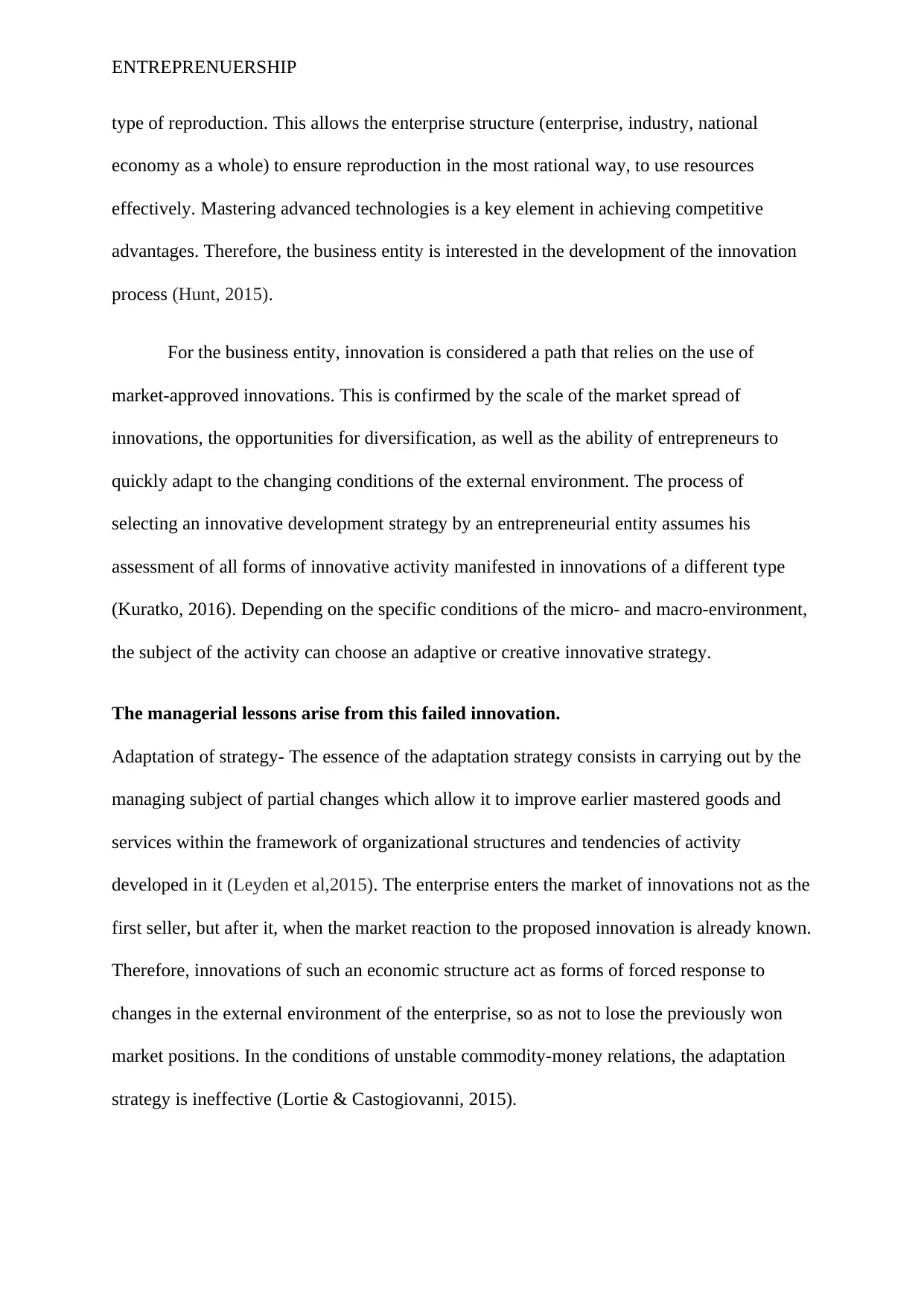
ENTREPRENUERSHIP
type of reproduction. This allows the enterprise structure (enterprise, industry, national
economy as a whole) to ensure reproduction in the most rational way, to use resources
effectively. Mastering advanced technologies is a key element in achieving competitive
advantages. Therefore, the business entity is interested in the development of the innovation
process (Hunt, 2015).
For the business entity, innovation is considered a path that relies on the use of
market-approved innovations. This is confirmed by the scale of the market spread of
innovations, the opportunities for diversification, as well as the ability of entrepreneurs to
quickly adapt to the changing conditions of the external environment. The process of
selecting an innovative development strategy by an entrepreneurial entity assumes his
assessment of all forms of innovative activity manifested in innovations of a different type
(Kuratko, 2016). Depending on the specific conditions of the micro- and macro-environment,
the subject of the activity can choose an adaptive or creative innovative strategy.
The managerial lessons arise from this failed innovation.
Adaptation of strategy- The essence of the adaptation strategy consists in carrying out by the
managing subject of partial changes which allow it to improve earlier mastered goods and
services within the framework of organizational structures and tendencies of activity
developed in it (Leyden et al,2015). The enterprise enters the market of innovations not as the
first seller, but after it, when the market reaction to the proposed innovation is already known.
Therefore, innovations of such an economic structure act as forms of forced response to
changes in the external environment of the enterprise, so as not to lose the previously won
market positions. In the conditions of unstable commodity-money relations, the adaptation
strategy is ineffective (Lortie & Castogiovanni, 2015).
type of reproduction. This allows the enterprise structure (enterprise, industry, national
economy as a whole) to ensure reproduction in the most rational way, to use resources
effectively. Mastering advanced technologies is a key element in achieving competitive
advantages. Therefore, the business entity is interested in the development of the innovation
process (Hunt, 2015).
For the business entity, innovation is considered a path that relies on the use of
market-approved innovations. This is confirmed by the scale of the market spread of
innovations, the opportunities for diversification, as well as the ability of entrepreneurs to
quickly adapt to the changing conditions of the external environment. The process of
selecting an innovative development strategy by an entrepreneurial entity assumes his
assessment of all forms of innovative activity manifested in innovations of a different type
(Kuratko, 2016). Depending on the specific conditions of the micro- and macro-environment,
the subject of the activity can choose an adaptive or creative innovative strategy.
The managerial lessons arise from this failed innovation.
Adaptation of strategy- The essence of the adaptation strategy consists in carrying out by the
managing subject of partial changes which allow it to improve earlier mastered goods and
services within the framework of organizational structures and tendencies of activity
developed in it (Leyden et al,2015). The enterprise enters the market of innovations not as the
first seller, but after it, when the market reaction to the proposed innovation is already known.
Therefore, innovations of such an economic structure act as forms of forced response to
changes in the external environment of the enterprise, so as not to lose the previously won
market positions. In the conditions of unstable commodity-money relations, the adaptation
strategy is ineffective (Lortie & Castogiovanni, 2015).
⊘ This is a preview!⊘
Do you want full access?
Subscribe today to unlock all pages.

Trusted by 1+ million students worldwide
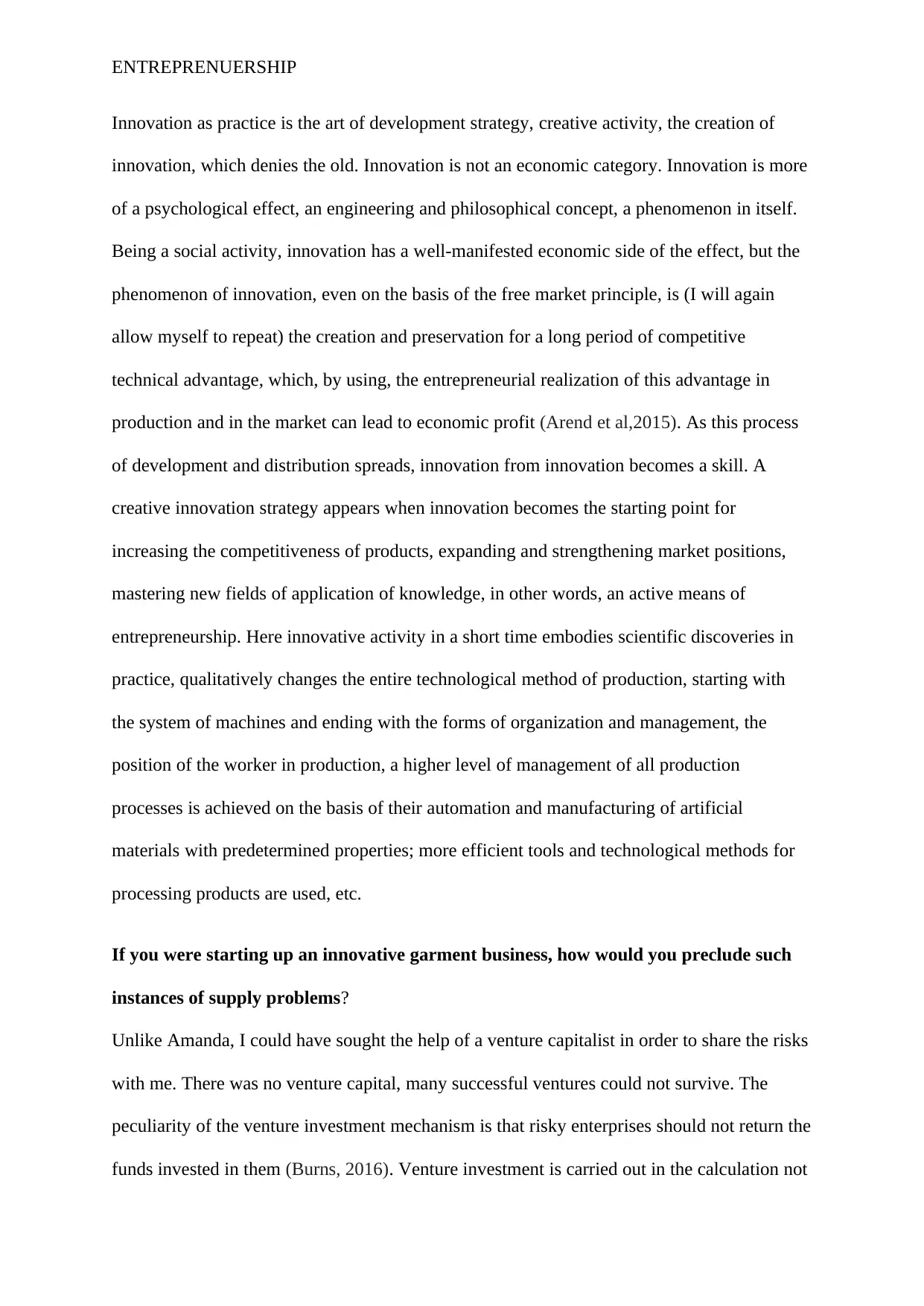
ENTREPRENUERSHIP
Innovation as practice is the art of development strategy, creative activity, the creation of
innovation, which denies the old. Innovation is not an economic category. Innovation is more
of a psychological effect, an engineering and philosophical concept, a phenomenon in itself.
Being a social activity, innovation has a well-manifested economic side of the effect, but the
phenomenon of innovation, even on the basis of the free market principle, is (I will again
allow myself to repeat) the creation and preservation for a long period of competitive
technical advantage, which, by using, the entrepreneurial realization of this advantage in
production and in the market can lead to economic profit (Arend et al,2015). As this process
of development and distribution spreads, innovation from innovation becomes a skill. A
creative innovation strategy appears when innovation becomes the starting point for
increasing the competitiveness of products, expanding and strengthening market positions,
mastering new fields of application of knowledge, in other words, an active means of
entrepreneurship. Here innovative activity in a short time embodies scientific discoveries in
practice, qualitatively changes the entire technological method of production, starting with
the system of machines and ending with the forms of organization and management, the
position of the worker in production, a higher level of management of all production
processes is achieved on the basis of their automation and manufacturing of artificial
materials with predetermined properties; more efficient tools and technological methods for
processing products are used, etc.
If you were starting up an innovative garment business, how would you preclude such
instances of supply problems?
Unlike Amanda, I could have sought the help of a venture capitalist in order to share the risks
with me. There was no venture capital, many successful ventures could not survive. The
peculiarity of the venture investment mechanism is that risky enterprises should not return the
funds invested in them (Burns, 2016). Venture investment is carried out in the calculation not
Innovation as practice is the art of development strategy, creative activity, the creation of
innovation, which denies the old. Innovation is not an economic category. Innovation is more
of a psychological effect, an engineering and philosophical concept, a phenomenon in itself.
Being a social activity, innovation has a well-manifested economic side of the effect, but the
phenomenon of innovation, even on the basis of the free market principle, is (I will again
allow myself to repeat) the creation and preservation for a long period of competitive
technical advantage, which, by using, the entrepreneurial realization of this advantage in
production and in the market can lead to economic profit (Arend et al,2015). As this process
of development and distribution spreads, innovation from innovation becomes a skill. A
creative innovation strategy appears when innovation becomes the starting point for
increasing the competitiveness of products, expanding and strengthening market positions,
mastering new fields of application of knowledge, in other words, an active means of
entrepreneurship. Here innovative activity in a short time embodies scientific discoveries in
practice, qualitatively changes the entire technological method of production, starting with
the system of machines and ending with the forms of organization and management, the
position of the worker in production, a higher level of management of all production
processes is achieved on the basis of their automation and manufacturing of artificial
materials with predetermined properties; more efficient tools and technological methods for
processing products are used, etc.
If you were starting up an innovative garment business, how would you preclude such
instances of supply problems?
Unlike Amanda, I could have sought the help of a venture capitalist in order to share the risks
with me. There was no venture capital, many successful ventures could not survive. The
peculiarity of the venture investment mechanism is that risky enterprises should not return the
funds invested in them (Burns, 2016). Venture investment is carried out in the calculation not
Paraphrase This Document
Need a fresh take? Get an instant paraphrase of this document with our AI Paraphraser
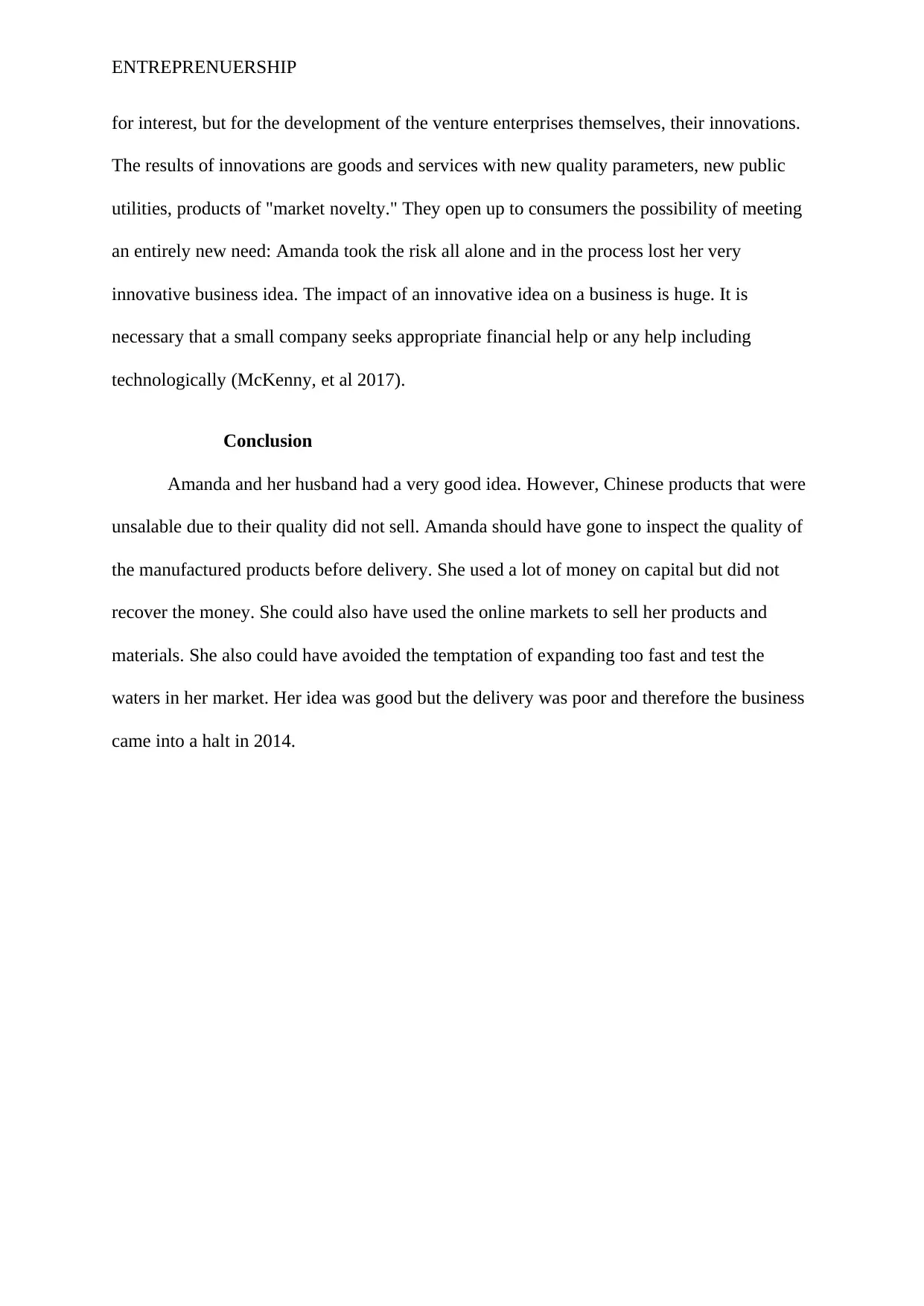
ENTREPRENUERSHIP
for interest, but for the development of the venture enterprises themselves, their innovations.
The results of innovations are goods and services with new quality parameters, new public
utilities, products of "market novelty." They open up to consumers the possibility of meeting
an entirely new need: Amanda took the risk all alone and in the process lost her very
innovative business idea. The impact of an innovative idea on a business is huge. It is
necessary that a small company seeks appropriate financial help or any help including
technologically (McKenny, et al 2017).
Conclusion
Amanda and her husband had a very good idea. However, Chinese products that were
unsalable due to their quality did not sell. Amanda should have gone to inspect the quality of
the manufactured products before delivery. She used a lot of money on capital but did not
recover the money. She could also have used the online markets to sell her products and
materials. She also could have avoided the temptation of expanding too fast and test the
waters in her market. Her idea was good but the delivery was poor and therefore the business
came into a halt in 2014.
for interest, but for the development of the venture enterprises themselves, their innovations.
The results of innovations are goods and services with new quality parameters, new public
utilities, products of "market novelty." They open up to consumers the possibility of meeting
an entirely new need: Amanda took the risk all alone and in the process lost her very
innovative business idea. The impact of an innovative idea on a business is huge. It is
necessary that a small company seeks appropriate financial help or any help including
technologically (McKenny, et al 2017).
Conclusion
Amanda and her husband had a very good idea. However, Chinese products that were
unsalable due to their quality did not sell. Amanda should have gone to inspect the quality of
the manufactured products before delivery. She used a lot of money on capital but did not
recover the money. She could also have used the online markets to sell her products and
materials. She also could have avoided the temptation of expanding too fast and test the
waters in her market. Her idea was good but the delivery was poor and therefore the business
came into a halt in 2014.
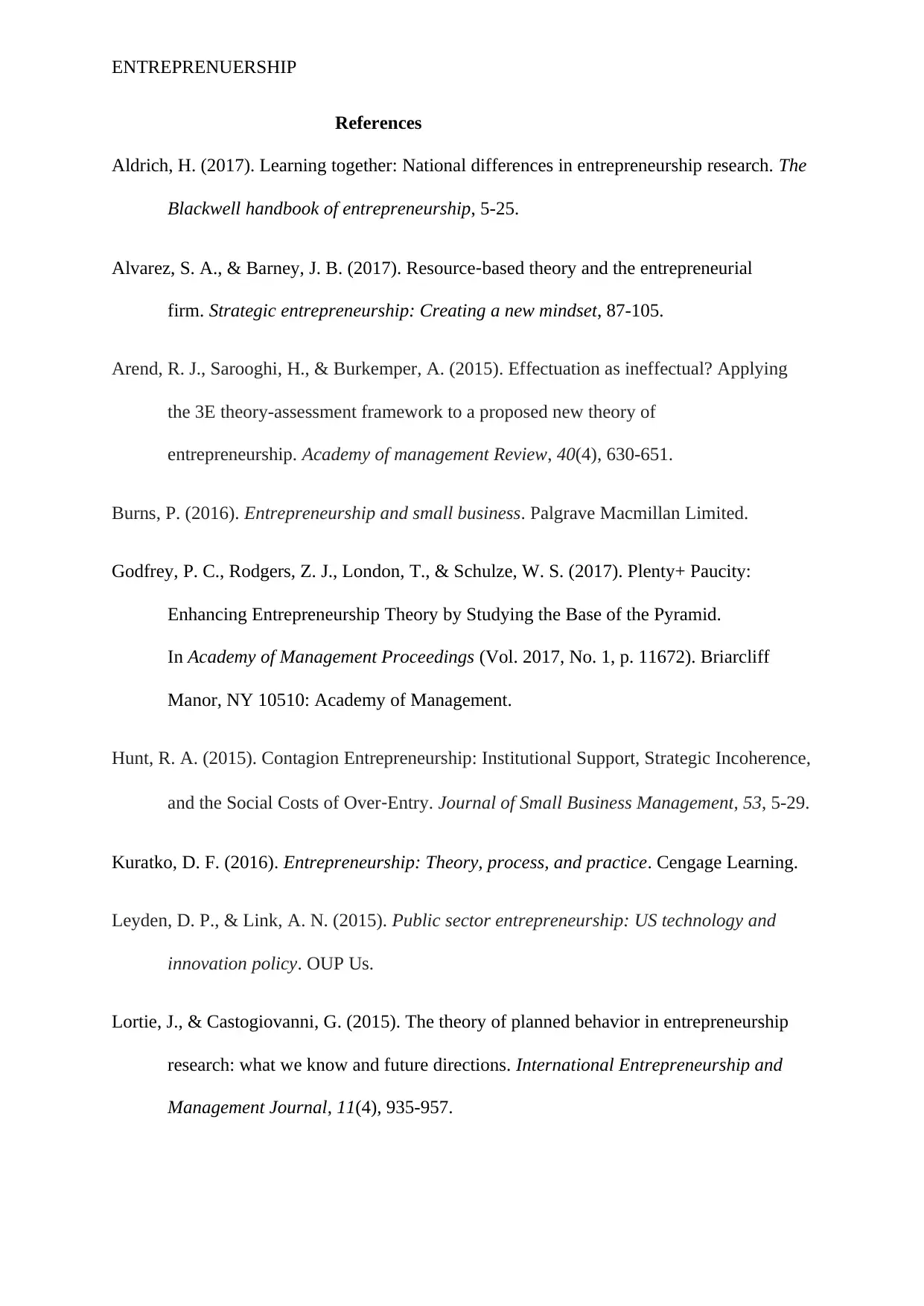
ENTREPRENUERSHIP
References
Aldrich, H. (2017). Learning together: National differences in entrepreneurship research. The
Blackwell handbook of entrepreneurship, 5-25.
Alvarez, S. A., & Barney, J. B. (2017). Resource‐based theory and the entrepreneurial
firm. Strategic entrepreneurship: Creating a new mindset, 87-105.
Arend, R. J., Sarooghi, H., & Burkemper, A. (2015). Effectuation as ineffectual? Applying
the 3E theory-assessment framework to a proposed new theory of
entrepreneurship. Academy of management Review, 40(4), 630-651.
Burns, P. (2016). Entrepreneurship and small business. Palgrave Macmillan Limited.
Godfrey, P. C., Rodgers, Z. J., London, T., & Schulze, W. S. (2017). Plenty+ Paucity:
Enhancing Entrepreneurship Theory by Studying the Base of the Pyramid.
In Academy of Management Proceedings (Vol. 2017, No. 1, p. 11672). Briarcliff
Manor, NY 10510: Academy of Management.
Hunt, R. A. (2015). Contagion Entrepreneurship: Institutional Support, Strategic Incoherence,
and the Social Costs of Over‐Entry. Journal of Small Business Management, 53, 5-29.
Kuratko, D. F. (2016). Entrepreneurship: Theory, process, and practice. Cengage Learning.
Leyden, D. P., & Link, A. N. (2015). Public sector entrepreneurship: US technology and
innovation policy. OUP Us.
Lortie, J., & Castogiovanni, G. (2015). The theory of planned behavior in entrepreneurship
research: what we know and future directions. International Entrepreneurship and
Management Journal, 11(4), 935-957.
References
Aldrich, H. (2017). Learning together: National differences in entrepreneurship research. The
Blackwell handbook of entrepreneurship, 5-25.
Alvarez, S. A., & Barney, J. B. (2017). Resource‐based theory and the entrepreneurial
firm. Strategic entrepreneurship: Creating a new mindset, 87-105.
Arend, R. J., Sarooghi, H., & Burkemper, A. (2015). Effectuation as ineffectual? Applying
the 3E theory-assessment framework to a proposed new theory of
entrepreneurship. Academy of management Review, 40(4), 630-651.
Burns, P. (2016). Entrepreneurship and small business. Palgrave Macmillan Limited.
Godfrey, P. C., Rodgers, Z. J., London, T., & Schulze, W. S. (2017). Plenty+ Paucity:
Enhancing Entrepreneurship Theory by Studying the Base of the Pyramid.
In Academy of Management Proceedings (Vol. 2017, No. 1, p. 11672). Briarcliff
Manor, NY 10510: Academy of Management.
Hunt, R. A. (2015). Contagion Entrepreneurship: Institutional Support, Strategic Incoherence,
and the Social Costs of Over‐Entry. Journal of Small Business Management, 53, 5-29.
Kuratko, D. F. (2016). Entrepreneurship: Theory, process, and practice. Cengage Learning.
Leyden, D. P., & Link, A. N. (2015). Public sector entrepreneurship: US technology and
innovation policy. OUP Us.
Lortie, J., & Castogiovanni, G. (2015). The theory of planned behavior in entrepreneurship
research: what we know and future directions. International Entrepreneurship and
Management Journal, 11(4), 935-957.
⊘ This is a preview!⊘
Do you want full access?
Subscribe today to unlock all pages.

Trusted by 1+ million students worldwide
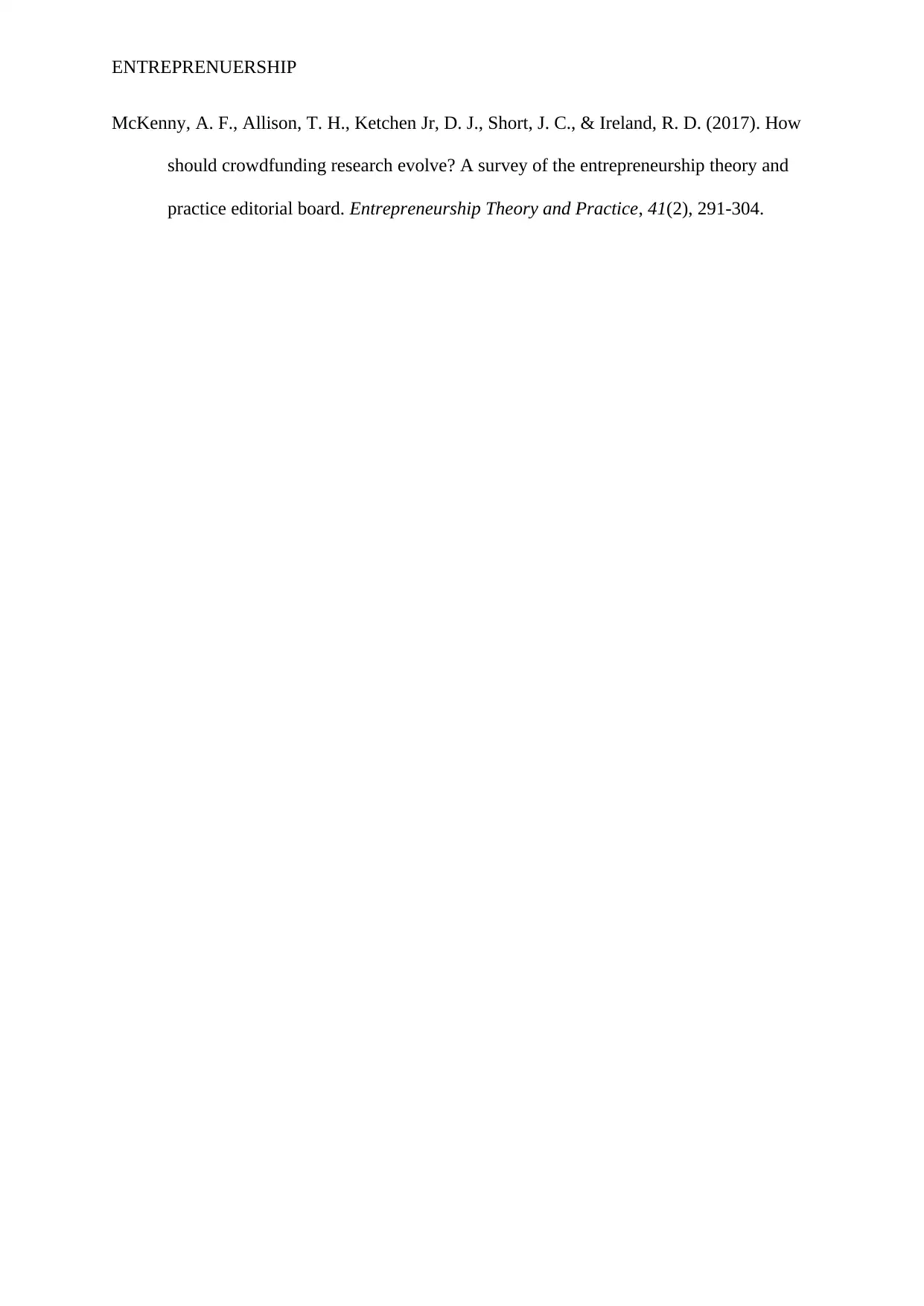
ENTREPRENUERSHIP
McKenny, A. F., Allison, T. H., Ketchen Jr, D. J., Short, J. C., & Ireland, R. D. (2017). How
should crowdfunding research evolve? A survey of the entrepreneurship theory and
practice editorial board. Entrepreneurship Theory and Practice, 41(2), 291-304.
McKenny, A. F., Allison, T. H., Ketchen Jr, D. J., Short, J. C., & Ireland, R. D. (2017). How
should crowdfunding research evolve? A survey of the entrepreneurship theory and
practice editorial board. Entrepreneurship Theory and Practice, 41(2), 291-304.
1 out of 10
Related Documents
Your All-in-One AI-Powered Toolkit for Academic Success.
+13062052269
info@desklib.com
Available 24*7 on WhatsApp / Email
![[object Object]](/_next/static/media/star-bottom.7253800d.svg)
Unlock your academic potential
Copyright © 2020–2025 A2Z Services. All Rights Reserved. Developed and managed by ZUCOL.





